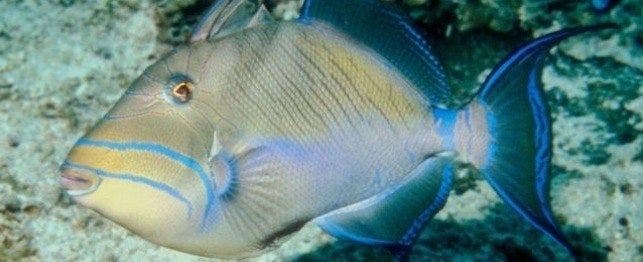
Choosing a Triggerfish
When taking a leisurely scuba dive along a reef, you may acquire a curious companion who cautiously swims beyond the range of your reach but remains with you for a good length of time – especially in more remote reefs. This is a common behavior among the bold and beautiful triggerfish.
These fish are very brave, very curious, very aggressive and lively. They range in color, from brilliant blue-greens to oranges and browns, and can sport various patterns of stripes and spots. They are very thin but oval in shape (side-view) with tiny, nearly useless pectoral fins.
Appearance
Triggerfish get their name from a dorsal spine that is erect and locked into place by a second spine behind it. When this second spine, the “trigger” is depressed, the first spine is released. They don’t use this as a “shooting” mechanism as the name may imply, but rather when frightened it will swim into a crevice or hole and erect these spines, making it virtually impossible to dislodge them. When they rest at night, they will find a safe spot in a nook, position themselves and “lock in,” so you need to provide some sort of shelter to accommodate this behavior.
Food
If you decide to keep one, it should be in a very large (100-gallon-plus) fish-only tank. They eat just about anything that fits into their mouth, including smaller fish, corals, crabs, shrimp, tunicates, cephalopods, brittlestars, sea urchins and algae. Some species of these fish grow to be enormous, sometimes reaching 20 inches even in captivity, so you really need ample space to keep one happy and healthy. You cannot keep any of these species with smaller fish (and fish of the same size). Without a doubt, the triggers will see their tank mates as dinner. Although all triggers will consume algae, to be healthy they must get a regular diet of meaty foods such as chopped up frozen shrimp and clams and live brine shrimp.
Not For Beginners
They require the same water quality of most reef fish. They are hardy, adapt well to aquarium life and can even be added shortly after your tank’s conditioning period. Despite their tolerance and hardiness, these fish are not recommended for beginning saltwater fish hobbyists because the biggest problems with keeping them come from their generally aggressive behavior. These fish are relatively expensive, running about $60 for a medium-sized species, and should be the last to go in a tank because of their territorial behavior. Inexperience and experimentation is not the way to go about learning how to keep them since you can destroy your entire community if you add the wrong species.
Types of Triggerfish
- Clown. One of the most prized of all triggers to keep is the clown triggerfish, Balistoides conspicillum, native to the Indo-Pacific. It’s bluish-black with large white oval spots, orange lips and a reticulated yellow pattern on its body. This fish can grow to about 20 inches in nature and will grow close to that size if your tank is large enough.
- Humu-Humu. Also known as Rhinecanthus aculeatus, this is a well-known and popular triggerfish species to keep. It comes from the Indo-Pacific and because of its unusual patterns and coloration is also known as the Picasso triggerfish. Smaller specimens will do well in a community aquarium and tend to be less aggressive overall than their relatives. This fish also requires some algae in its diet. It is aggressive toward those of its kind.
- Queen. Balistes vetula, from the Caribbean is also more docile than most others in its family. It is generally golden in color with curved blue stripes around its head. As it matures, some of these species will grow long filaments on its fins. It is a hardy species that grows rapidly.
- Niger. Odonus niger, also called the black triggerfish, grows to be about 16 inches. It is also a rather peaceful species, as triggerfish go, and likes chopped up fresh or frozen fish. These species are peaceful enough that they can be kept in a reef tank or with other fish (they can get along with some tangs and rabbitfish) but only if they’re not too big.